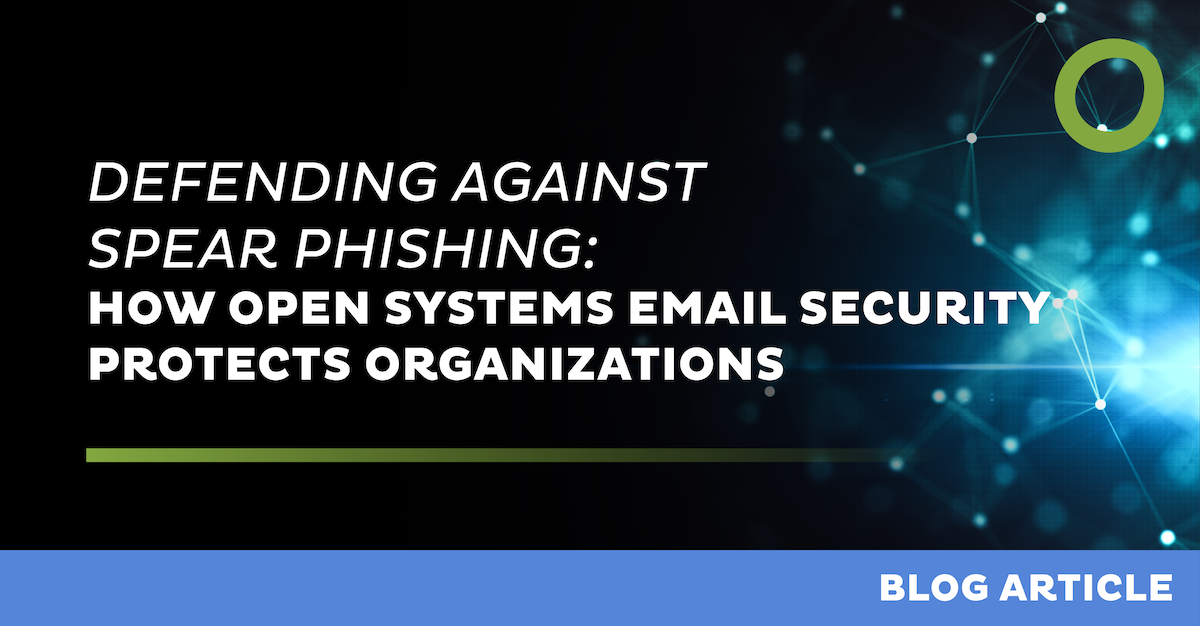
Defending Against Spear Phishing: How Open Systems Email Security Protects Organizations


What is Spear Phishing?
Spear phishing represents one of the most sophisticated and targeted forms of cyberattack, tailored to deceive individuals with personalized messages and emails that appear genuine. Unlike general phishing attempts, spear phishing involves detailed research on the target, including their work role, personal interests, or recent activities, all aimed at increasing the credibility of the fraudulent communication. These attacks often aim to steal sensitive information, compromise accounts, or facilitate broader breaches within an organization.
Real-World Examples: Spear Phishing in Action
Recent incidents underscore just how damaging spear phishing can be—both financially and operationally.
- Colonial Pipeline Attack (2021): One of the most disruptive infrastructure cyberattacks in U.S. history began with a phishing email. The attackers shut down critical fuel supply systems, leading to panic buying and widespread shortages. The company ultimately paid a $4.4 million ransom, highlighting how a single deceptive email can have far-reaching consequences. [1]
- Void Blizzard APT Campaign (2024): A newly identified Russian APT group known as Void Blizzard targeted NATO-based organizations and NGOs with sophisticated spear phishing attacks. After infiltrating the Dutch police, the group launched phishing campaigns using emails disguised as trusted partners to deliver malware and exfiltrate sensitive data. This shows how state-sponsored attackers use phishing to achieve geopolitical goals. [2]
These examples highlight a growing trend: modern phishing attacks are more targeted, more deceptive, and more damaging than ever. Whether motivated by financial gain or strategic influence, they demand a more advanced, adaptive email security approach.
Tactics and Technologies to Combat Spear Phishing
Protecting against spear phishing requires a multi-layered approach [3] that combines robust technological solutions with vigilant user practices. Key tactics and technologies include:
SPF, DKIM, and DMARC Configuration
Sender Policy Framework (SPF), DomainKeys Identified Mail (DKIM), and Domain-based Message Authentication Reporting and Conformance (DMARC) are essential protocols for email authentication. These prevent attackers from spoofing an organization’s domain by verifying the legitimacy of email senders.
Email Content Scanning
Modern systems scan incoming and outgoing emails for malicious attachments, links, and manipulations in text. They analyze the context and behavior of messages to catch even subtle signs of phishing.
AI and Machine Learning
AI and ML algorithms analyze vast datasets to detect suspicious behavior and zero-day threats. These technologies are essential for identifying attacks that traditional filters miss, such as zero-hour phishing and AI-generated scams.
How Open Systems Email Security Addresses Spear Phishing
Deploying and managing these protections in-house is often complex, time-consuming, and resource-intensive. Open Systems offers a fully managed email security service designed to implement and operate a comprehensive, multi-layered defense—so organizations don’t have to.
Our Standard Email Security provides foundational defenses implemented and maintained by our security experts:
- SPF, DKIM, and DMARC Management: We ensure proper setup and continuous management of authentication protocols to prevent domain spoofing and reduce the risk of impersonation.
- 24×7 change and incident Management: Our team ensures that your email security setup is properly configured and functioning as intended, resolving configuration issues, handling false positives, and addressing integration challenges to ensure legitimate emails are delivered while malicious ones are blocked.
- Phishing Detection and Blocking: Leveraging our Threat Protection and Secure Web Gateway services, we stop phishing attacks before they ever reach a user’s inbox.
For organizations facing more sophisticated threats, our Advanced Email Security integrates cutting-edge AI and machine learning, fully managed:
- Zero-Hour Phishing: Detects and blocks never-before-seen phishing attacks in real time using behavioral analytics and live threat intelligence.
- LLM-Assisted Thread Hijacking: Uses advanced language models to detect subtle anomalies in legitimate conversations—flagging AI-generated responses that hijack trusted threads.
- Malicious URLs in Visual Content: Scans embedded visual elements like QR codes and images for hidden malicious URLs that traditional filters overlook.
- Business Email Compromise (BEC): Analyzes sender identity, behavioral context, and message patterns to detect and prevent fraud and impersonation attempts.
By managing and maintaining these complex layers of protection on behalf of our customers, Open Systems reduces the operational burden on IT and security teams—while ensuring resilient, adaptive defenses against ever-evolving email threats.
Conclusion
Spear phishing continues to evolve, leveraging new technologies and techniques to breach organizational defenses. Open Systems equips businesses not only with the tools but also with the expertise and operational support to stay ahead. From foundational protections like SPF and DMARC to advanced AI-driven defenses, our managed Email Security service delivers peace of mind in an increasingly hostile digital world.
Sources and References
[1] Colonial Pipeline Ransomware Attack, 2021: https://www.axios.com/2021/05/19/colonial-pipeline-darkside-4-million-ransomware
[2] Void Blizzard APT Targeting NATO-based Orgs, 2024: https://www.csoonline.com/article/3996192/new-russian-apt-group-void-blizzard-targets-nato-based-orgs-after-infiltrating-dutch-police.html
[3] https://www.csoonline.com/article/566789/what-is-spear-phishing-examples-tactics-and-techniques.html
Leave Complexity
Behind
To learn how Open Systems SASE Experience can benefit your organization, talk to a specialist today.
Contact Us



